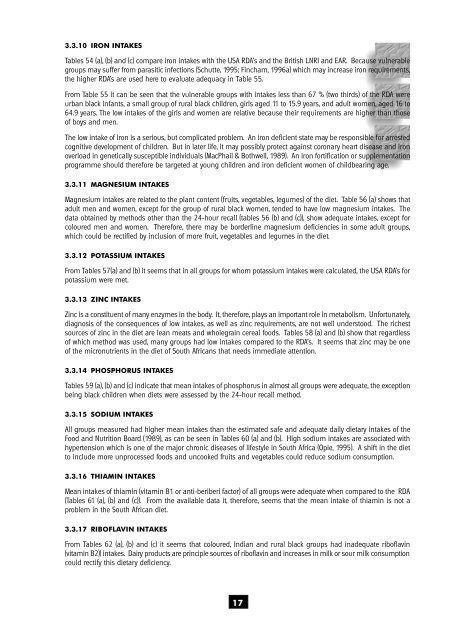the nutritional status of - Health Systems Trust
the nutritional status of - Health Systems Trust
the nutritional status of - Health Systems Trust
You also want an ePaper? Increase the reach of your titles
YUMPU automatically turns print PDFs into web optimized ePapers that Google loves.
3.3.10 IRON INTAKES<br />
Tables 54 (a), (b) and (c) compare iron intakes with <strong>the</strong> USA RDA’s and <strong>the</strong> British LNRI and EAR. Because vulnerable<br />
groups may suffer from parasitic infections (Schutte, 1995; Fincham, 1996a) which may increase iron requirements,<br />
<strong>the</strong> higher RDA’s are used here to evaluate adequacy in Table 55.<br />
From Table 55 it can be seen that <strong>the</strong> vulnerable groups with intakes less than 67 % (two thirds) <strong>of</strong> <strong>the</strong> RDA were<br />
urban black infants, a small group <strong>of</strong> rural black children, girls aged 11 to 15.9 years, and adult women, aged 16 to<br />
64.9 years. The low intakes <strong>of</strong> <strong>the</strong> girls and women are relative because <strong>the</strong>ir requirements are higher than those<br />
<strong>of</strong> boys and men.<br />
The low intake <strong>of</strong> iron is a serious, but complicated problem. An iron deficient state may be responsible for arrested<br />
cognitive development <strong>of</strong> children. But in later life, it may possibly protect against coronary heart disease and iron<br />
overload in genetically susceptible individuals (MacPhail & Bothwell, 1989). An iron fortification or supplementation<br />
programme should <strong>the</strong>refore be targeted at young children and iron deficient women <strong>of</strong> childbearing age.<br />
3.3.11 MAGNESIUM INTAKES<br />
Magnesium intakes are related to <strong>the</strong> plant content (fruits, vegetables, legumes) <strong>of</strong> <strong>the</strong> diet. Table 56 (a) shows that<br />
adult men and women, except for <strong>the</strong> group <strong>of</strong> rural black women, tended to have low magnesium intakes. The<br />
data obtained by methods o<strong>the</strong>r than <strong>the</strong> 24-hour recall (tables 56 (b) and (c)), show adequate intakes, except for<br />
coloured men and women. Therefore, <strong>the</strong>re may be borderline magnesium deficiencies in some adult groups,<br />
which could be rectified by inclusion <strong>of</strong> more fruit, vegetables and legumes in <strong>the</strong> diet.<br />
3.3.12 POTASSIUM INTAKES<br />
From Tables 57(a) and (b) it seems that in all groups for whom potassium intakes were calculated, <strong>the</strong> USA RDA’s for<br />
potassium were met.<br />
3.3.13 ZINC INTAKES<br />
Zinc is a constituent <strong>of</strong> many enzymes in <strong>the</strong> body. It, <strong>the</strong>refore, plays an important role in metabolism. Unfortunately,<br />
diagnosis <strong>of</strong> <strong>the</strong> consequences <strong>of</strong> low intakes, as well as zinc requirements, are not well understood. The richest<br />
sources <strong>of</strong> zinc in <strong>the</strong> diet are lean meats and wholegrain cereal foods. Tables 58 (a) and (b) show that regardless<br />
<strong>of</strong> which method was used, many groups had low intakes compared to <strong>the</strong> RDA’s. It seems that zinc may be one<br />
<strong>of</strong> <strong>the</strong> micronutrients in <strong>the</strong> diet <strong>of</strong> South Africans that needs immediate attention.<br />
3.3.14 PHOSPHORUS INTAKES<br />
Tables 59 (a), (b) and (c) indicate that mean intakes <strong>of</strong> phosphorus in almost all groups were adequate, <strong>the</strong> exception<br />
being black children when diets were assessed by <strong>the</strong> 24-hour recall method.<br />
3.3.15 SODIUM INTAKES<br />
All groups measured had higher mean intakes than <strong>the</strong> estimated safe and adequate daily dietary intakes <strong>of</strong> <strong>the</strong><br />
Food and Nutrition Board (1989), as can be seen in Tables 60 (a) and (b). High sodium intakes are associated with<br />
hypertension which is one <strong>of</strong> <strong>the</strong> major chronic diseases <strong>of</strong> lifestyle in South Africa (Opie, 1995). A shift in <strong>the</strong> diet<br />
to include more unprocessed foods and uncooked fruits and vegetables could reduce sodium consumption.<br />
3.3.16 THIAMIN INTAKES<br />
Mean intakes <strong>of</strong> thiamin (vitamin B1 or anti-beriberi factor) <strong>of</strong> all groups were adequate when compared to <strong>the</strong> RDA<br />
(Tables 61 (a), (b) and (c)). From <strong>the</strong> available data it, <strong>the</strong>refore, seems that <strong>the</strong> mean intake <strong>of</strong> thiamin is not a<br />
problem in <strong>the</strong> South African diet.<br />
3.3.17 RIBOFLAVIN INTAKES<br />
From Tables 62 (a), (b) and (c) it seems that coloured, Indian and rural black groups had inadequate rib<strong>of</strong>lavin<br />
(vitamin B2)) intakes. Dairy products are principle sources <strong>of</strong> rib<strong>of</strong>lavin and increases in milk or sour milk consumption<br />
could rectify this dietary deficiency.<br />
17
















